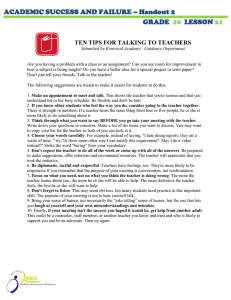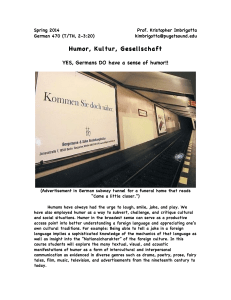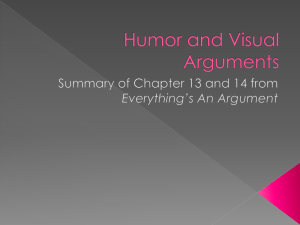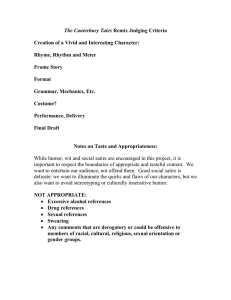Adding Zest to OPAC Instruction - CSUSB ScholarWorks
advertisement
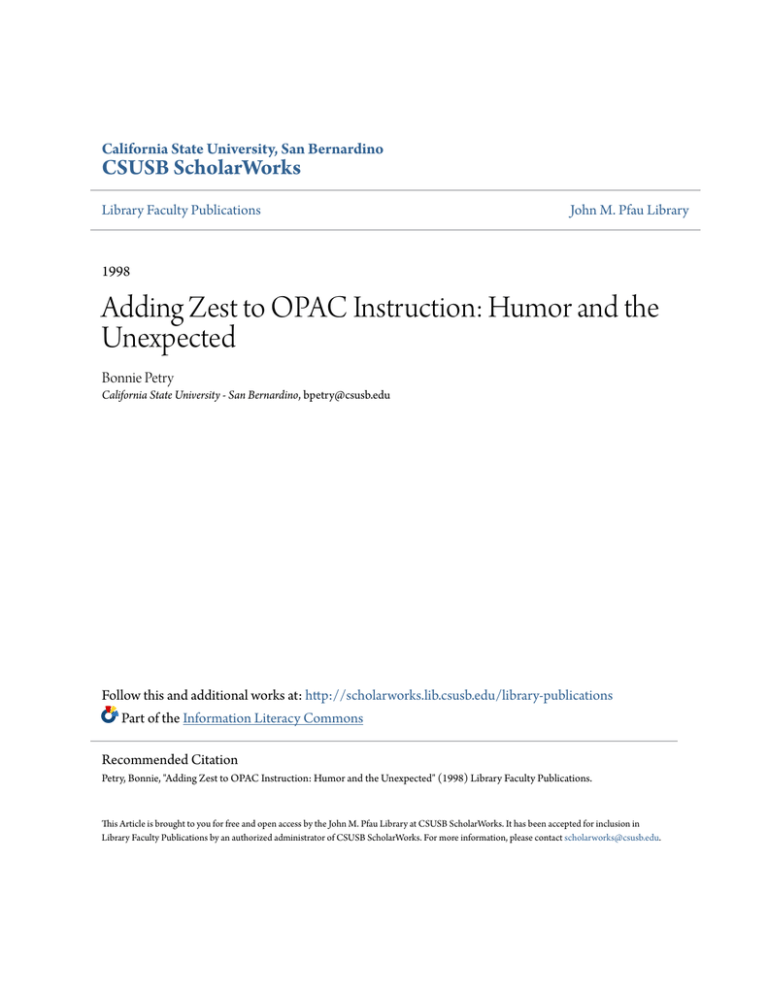
California State University, San Bernardino CSUSB ScholarWorks Library Faculty Publications John M. Pfau Library 1998 Adding Zest to OPAC Instruction: Humor and the Unexpected Bonnie Petry California State University - San Bernardino, bpetry@csusb.edu Follow this and additional works at: http://scholarworks.lib.csusb.edu/library-publications Part of the Information Literacy Commons Recommended Citation Petry, Bonnie, "Adding Zest to OPAC Instruction: Humor and the Unexpected" (1998) Library Faculty Publications. This Article is brought to you for free and open access by the John M. Pfau Library at CSUSB ScholarWorks. It has been accepted for inclusion in Library Faculty Publications by an authorized administrator of CSUSB ScholarWorks. For more information, please contact scholarworks@csusb.edu. Adding Zest to OPAC Instruction: Humor and the Unexpected Bonnie L. Petry ABSTRACT. T hi s art icle evo lved from " Getting Stu dents to NOTIS, " a presentation that the au thor gave at th e 1995 Chicago NOTIS Users Group M eeting (NUGM) conference. H umor is a desirable clement of all types of instructi on, particularl y bibliographi c instruction. A good meth od fo r injecting some humor into bibliogra phic instruction is introducing w himsica l cata log entries. T he auth or identifies fi ve types of bib I iograph ic records use ful for thi s approach, prov ides strategies for locati ng them, and suggests ways to incorporate them into a class. [Arlicle copies aFailable for a fee from The Haworlh Documenl De/ive1y Se1vice: I -800-342-9678. E-mail address: gelinfo@lwll'orlhpressinc.comj KEYWORDS. H um or, zes t, bibliograp hic instruction, 81, unexpected, search ex amples Spilltead: an informal ltis101y, by Michael A rthur Lewis Rubbish! Tlte arcltaeo/ogy of garbage, by Willi am L. Rathj e Bonn ie L. Petry (MLS, Uni versity of Cal ifornia, Los Angeles) is Refere nce Librarian at Ca lifo rnia State Un ive rsity, San Bernardino. College & Unde rgrad uate Libraries, Vol. 5(2) 1998 © 1998 by The Haworth Press, IJlC. All rig hts rese rved. 75 76 COLLEGE & UNDERGRADUATE L/JJRARIES To some college students, libraries are intimidating, dusty, boring places, and librarians are the most humorless, uninterest ing people on earth. The thought of spending an entire hour in a bibliographic in struction session listening to one is absolutely mind-numbing. According to Tara Lynn Fulton, such student preconceptions " ... are precisely what make humor a perfect approach . Its surprise power is tremendous" (Fulton 1985, 8). Public speakers commonl y use humor as an effective presentation tool. In recommending strategies for bibliographic instruction, Paula N. Warnken and Victoria L. Young drew upon the literature of professional trainers: Fun. Enjoyment. Trainers view these two elements as essential in the promotion of learning. This does not necessarily require that librarians have a sense of humor, something too often lack ing in bibliographic instruction. Learning to use the library is serious business, but librarians often take themselves too seri ously in the classroom ... Humor needs to become a regular element in bibliographic instruction. (Warnken 1991, 94) Humor in an instructional setting can rightfull y be labeled " multitasking. " It not on! y wakes up the Iisteners, but also establishes a relaxed, friendly rapport with students-a crucial consideration for optimal teaching and learning. Important concepts and points are more memorable when emphasized with wit. In additi on, adding humor to the materia l helps keep the librarian interested. Bibliographic instruction can become repetitive; if the librarian is bored, why should the students be otherwise? In order to combat the "taxidermy shop syndrome"- rows of glassy-eyed heads staring blankly at the instructor- present students with the unexpected to capture attention and add some sparkl e to otherwise dry material. MORE MEMORABLE OPAC JNSTRUC110N Introducing the use of an on-line public access catalog (O PAC) lends itself remarkably well to humorous instruction. Almost any library collection wi ll yield some absurd and unu sual items to use as exa mpl es. Robert M. Kapl an and Gregory C. Pascoe concluded th at " .. . the benefits of humor in the classroom are most clearly demonstrable for recall of humorous examples" (Kaplan 1977, 64). /Jonnie L. Pe/ly 77 Here are fi ve basic types of bibliographic records usefu l for hum orous instruction: J. Intentionall y humorous books: Welles, James F. The story of stupidity : a history of westem idiocy from the days of ancient Greece to the moment you saw this book. 2. Books on unexpected topics- watch for unusual Library of Congress Subject Headings, such as " Names Carved on Trees," " Underwear," and " Snobs" : Dingwall, Eri c John 1he girdle of chastity; a fascinating history of chastity belts. 3. Serious books that are unintentionally funny: Richards, Steve In visibility: mastering the art of vanishing. 4. Books which lend themselves to appropriate witty or lighthearted remarks: 13rod, Craig Teclmostress: the human cost of the complller revollllion. 5. Ordinary books, which become much more interesting when co llected together under a theme: Multhauf, Robert P. Neptune 's gift: a hist01y of common salt. Pepper, Art Straight life: the sto1y of Art Peppe1: Heins, Ma1jorie Culling the mustard. PUTTING IT TOGETHER Not every example needs to be funny. Try to strike a balance. Humor should enhance the learning experience, not detract from it. 78 COLLEGE & UNDERGRADUATE Ll/JRARIES Use a blend of the ordinary and the unexpected in different proportions for diffe rent grade levels. For example, include more surpri ses in exercises intended for an English 101 class than a graduate seminar, since younger students are a tougher audience. For maxi mum impact, open with an attention-getter and include enough unexpected material to keep students guessing about what is coming next. The goa l is to have what appears to be a boring Iist of exercises yield un foreseen, interesting results. The only way to test the materi al is to try it out on several classes. Wh at receives a lukewarm reception from one class may captivate another. At the beginning of class, give each student a handout or worksheet of OPAC exercises consisting of a numbered list of author, title, subject and keyword sea rches-three of each. Thi s provides plenty of exercises, should the class progress qui ckly. In slower cl asses, skip some as needed. Having a printed guide is important. It ensures that everyone knows exactly what to type in and how to spe ll it. That is preferable to the worksheet scenario, since things can be explained, questions fielded, and comments made along the way as the students view materi al. CLASSROOM EXAMPLES Here are the humorous or unusual excerpts from exercises for three different classes. The author and title of the retrieved items are in the left-hand column; possible comments an instructor might make to help the humor along appear on the right. Management 495 These students were instructed to research a profession of interest, then find detailed information on the work environm ent of three appropriate compani es. Rich, George E. Artistic horse-shoeing. Can't decide between the blacksmithing and being an arti st? Richards, Steve Levi/a/ion: whal il is, how il works, how lo do il. An altern ati ve ca ree r. Bonnie L. Pet1y Pfoul, Ima 79 N ote the author's name- 'Tm a fool. " Underwater basket1veal'ing: a reimbursable I'Ocational trade? Psychology 311 Psychology 31J: Introduction to Experim ental Psychology int roduces the psychology maj or to laboratory work and sources such as P.~ychological Absimcls and Social Science Cilalionlndex. Phillips, Ada m On kissing. tickling, and being IJored: p!>ychoanaly tic essays 011 the unexamined life. T he titl e says it all. Sk inner, B urrhus Frederic Now yo u know w hy he always we nt by " B. E" Maybe his parents didn 't like him . Enjoy old age. Eysenck , H.J. Mimh valching: why people beha l'e the ll'ay they do. Fow ler, O.S. Phrenology: a practical guide to your head. Sacks, O live r W. The man 111ho mistook his 111ije fo r a hat and other clinical tales. Is so meone driv ing you nuts and you' re not sure w hy? The V ictorians believed that the bumps on your head revealed your personality. O live r Sacks is a neurosurgeon w ho actually had a patient mistake his wi fe for his hat. English 101 Here, a tabloid newspaper theme is used to capture the interest of the entry level , f reshman student. W urf, Ka rl To serl'e m an: a cookbook for people. As opposed to w hat? Baker, Jerry Make friends 111ith your fruit trees. If you' re a f111it, this makes good sense. Chase, Pamela Take two crystals and call me in the morning. The Newcastle guide to healing 1vitlt CJystals. 80 COLLEGE & UNDERGRADUATE LIIJRARIES The psychic yellotv pages. If you ' re psychi<.:, w hy do you need yel low pages? Friesner, Esther M. Love those supermarket tab loids! Alien pregnant by Elvis. English 101 The unlikely theme of this set of exercises is particu larly well suited to an ea rly morning class. It is also ideal for a nutrition or health class. Feldman, David Wh o putthe butter in butte1[ly? Sholberg, Peter L. Apricot, cheny. nectarine, peach, plum, prune pest management. (Found wi th the search, " fruitCalifornia. " ) T hey say California is like grano la- fruits, nuts, and flakes. Bara velli, Giulio Cesare Stalin s toast. W ickize r, Vernon Dale Coff ee, tea, and cocoa; an economic and political analysis. STRATEGIES FOR COLLECTING YOUR OWN EXAMPLES 1. Keep a sharp eye for appropriate books whether rev iewi ng new books, looking for items in the stacks, or staffing the reference desk. Strange things have a way of appearing even during the most innocent activ ities. 2. Actively search the OPAC. Th is is a wonderful " between questions" reference desk project. Scan titl es under subjects relating to the particular class, or use free association and make the first word that comes to mind a keyword search. 3. Share what you find. Co-workers may get a chuckle out of your discoveries and be encouraged to bring items they find to your attention. 4. Allow a particular record to suggest a theme, or just select something and try to bui ld on it. Some ideas are: Color, Brea kfast, Bonnie L. Pet1y 81 Lunch, Dinner, Hamburger Stand, Animals, Superm arket Tabloid, and Holidays. 5. Check the selected list of findings, located in the Appendix, aga inst local holdings. 1-linl: Remember that some items may be useful for more than one set of exercises. SELECTION CRITERIA Each record found must be evaluated to determine its usefulness. Inev itably, some wi ll not be suitabl e. I. Does the record fit into one of the fo llowing categories? Intentionally humorous Unexpected topic Unintentionally funny Lends itself to remarks Fits a particular theme 2. What type of sea rch or feature wou ld the record best illustrate? In addition to covering author, title, subject and keyword searches, records th at show particul ar types of displays or other OPAC features may be included. 3. Is anything difficult to spell and pronou nce? Remember that records with difficult titles, for exampl e, may be useful for other types of searches. SUCCESSES AND FAILURES Sometimes humor fa ll s flat. There are always students- and occasionally entire classes- who remain unreachable no matter what, but the reachable ones make the effort worthwhile. One particul arly apathetic class refused to even smile at anything. Towards the end of the session, the students did a keyword search for " yellow and pages." This search retrieved two screens of items. They went to the second screen where Tlte Psychic Yellow Pages appeared. · 82 COLLEGE & UNDERGRADUA7E LIBRARIES " I knew that one was there!" I excl aim ed. One student burst out laughing, but stopped when he realized the others were silent. He looked around , waved his arm s, and sa id, "Come on! That was funny! " CONCLUSION One of the most important opportunities presented to students in bibliographic instruction sessions is the chance to make a positive, professional connection with a reference librarian. Hum or helps ensure a positive "first contact " and ampli fies other desi rable aspects of the learning process. OPAC instruct ion is an exce llent vehicle for introduci ng humor into a bibliographic instruction session via humorous or unexpected examples. Collecting, selecting, and using such examples is not diffi cult. Thoughtful selection and implementation will increase the chances of success. Humor is a form of creativity; to understand a joke usuall y requ ires thinking about a concept in a creative way. Claudia E. Cornett says that " Humor in the curricu lum stimulates the kinds of thinking processes used frequently by highly creative people" (Cornett 1986, 11). Humor in OPAC instruction may help to " limber up" students' minds and promote a positive computer experience. The potential benefits are well worth investigating. REFERENCES Ba ughman, M. Da le. /Jaugl11nan 's /-lall(/hook of Humor in Education. West Nyack , New York: Parker Publishing Co., Inc., 1974. Cornett, Claudi a E. Leaming Through Laughter: Humor in the Classroom. Fastback, ed. Derek L. Burleso n, no. 241. Bloo mington, Ind ia na: Phi Deltn Kappa Educational Foundntion, 1986. Fulto n, Tara Ly nn, " Plain (Well, Not Just Plain) Fun : The Pote ntial for Humor in the Academic Library ' One-Shot Lecture,"'' June 1985, ED RS, ED 274353, mic rofiche. Gline r, Art, " Humo r and Co mmunication," Pe1Jormances and In s/me/ion 28, no. 2 (February 1, 1989): 38. Kap lan, Robert M. and Gregory C. Pascoe. " Humorous Lectu res and Humoro us Exa mples: Some Effects Upon Co mpre hension and Rete ntion.,. Jouma f of Educational Psychology 69, no. 1 ( 1977): 6 1-65. Bonnie L. J>etry 83 Korobk in , Debra. " Humor in the Classroom: Co nsiderations and Strategies. " College Teaching 36, no. 4 (Falll988): 154- 158. MacAdam, Barba ra. '' Humor in the Classroom: Implications for the Bibliographic Instruction Librarian. " College and Research Libraries 46, no. 4 (July 1985): 327-333. Osborn, Nancy Seale, " Lib rarian Humor in the Classroo m and Reference," report presented at a poster session at the Annua l Meeting of the State Uni versit y of New Yo rk, Librarians' Associatio n, June 1992, EDRS, ED 34901 8, microfiche. Stebbins, Robert A., "The Role of Humour in Teaching: Strategy and Se lf-Exp ression." In Teac her Strategies: Explorations in the Sociology of the Schoo l, eel. Peter Woods. London: Croom Helm, Ltd., 1980. Warnken, Pau la N., and Victoria L. Young. "Application of Tra ining Principles and Techniques for Successful Library Instruction. " Reference Sen•ices Re11iew 19, no. 4 (Wi nter 1991 ): 91-96. Wh yte, Susa n Barnes. "Stu ffy No More: Passio n and Jlumor in the Library. ·• College and Research Libraries News (March 1996): 138-14 1. APPENDIX. BIBLIOGRAPHY OF THE ABSURD Armo ur, Richard Willard. The happy bookers : a playful hist01y of librarians and their world from the stone age /o !he dis/an/ fulure. Barker, A.J. Dog breeds. Barlow, Ronald S. The vanishing American oulhouse: a history of C0/111/Jy plumbing. Cane, William . The arl of kissing. Rev. eel . Covill e, Bruce. A liens ate my homework. Dailey, Dennis M. The sexually 11111/SIWI: g uide to understanding and helping. Dundes, Alan. Life is like a chicken coop ladder: a portrait of German culture tltrough fo lklore. Eato n, Marc ia Mueldcr. Art and nonart: reflections on an orange crate and a moose call. 84 COLLEGE & UNDERGRADUATE LIBRARIES Elfman, Eric. Almanac of the gross, disgusting & totally repulsive: a compendium of jitlsome facts. Funk, Charles Earle. Horsefeathers and other curious words. Gardner, Martin . Knolled doughnuts and other mathematical entertainments. 1-Iandsard, Peter. What bird did that ?: a driver :5 guide to some common birds of North America. Henry, Paul -Marc. Poodles/an; a poodle's eye l'ie w of history. Hilton, Ordway. Detecting and deciphering erased pencil writing. Jaubert, Alain. Making people disappear: an amazing chronicle of photographic deceptio11. Kaufman , Margo. 1-800-am-IIIUIS? King, Stephen and F-Stop Fitzgerald. Nightmares i11 the sky: gargoy les a11d grotesques. Kitchen Fairy. The gay of cooki11g. Lewis, Michael Arthur. Spithead: an informal history. Martin , Bi ll. Chicka chicka boom boom. Martin, Richard. Jocks and nerds : me11 :5 sty le in th e twentieth centwy. Montejo, Victor. The bird who cleans the world: and other May an fables. Bonnie L. PetI)' 85 Ogil vie, Willi am G. Umty -iddy -umty: the story of a Canadian signaler in the first world W(//: Pogue, William R. How do you go to the bathroom in space? Rathje, Wi lli am L. Rubbish!: the archaeology of garbage. Seltzer, Richard . The lizard of Oz: an adult fable Stevens-Cox, James. An illustrated dictionary of hairdressing and wigmaking; containing word.\~ terms, and phrases (current and obsolete), dialectal, f oreign, and technical, used in Britain and America pertaining to the crafts of hairdressing and 1vigmaking; also words deri1•ed from these crajis ha ving a wider use, but excluding, with some necessary exceptions, medical, chemical and scientific terms. Tiger, Lionel and Fox , Robin. The imperial animal. Tanner, Lisa. The potato experience: wonderful ways with potato outers and innards : recipes, illustrations, calligraphy, and hand-lellering. Trudeau , G.B. In search of Reagan 5· brai11. Wigglesworth, Vincent B. Insect physiology. Womack, Tommy. Cheese chronicles: the true story of a rock and roll band you 've never heard of Zinsser, Hans. Rats, lice a11d history; being a study in biography, which, ajter twelve prelim inary chapters indispensable f or the preparation of the lay reade1; deals with the life l1istory of typhus [e va
